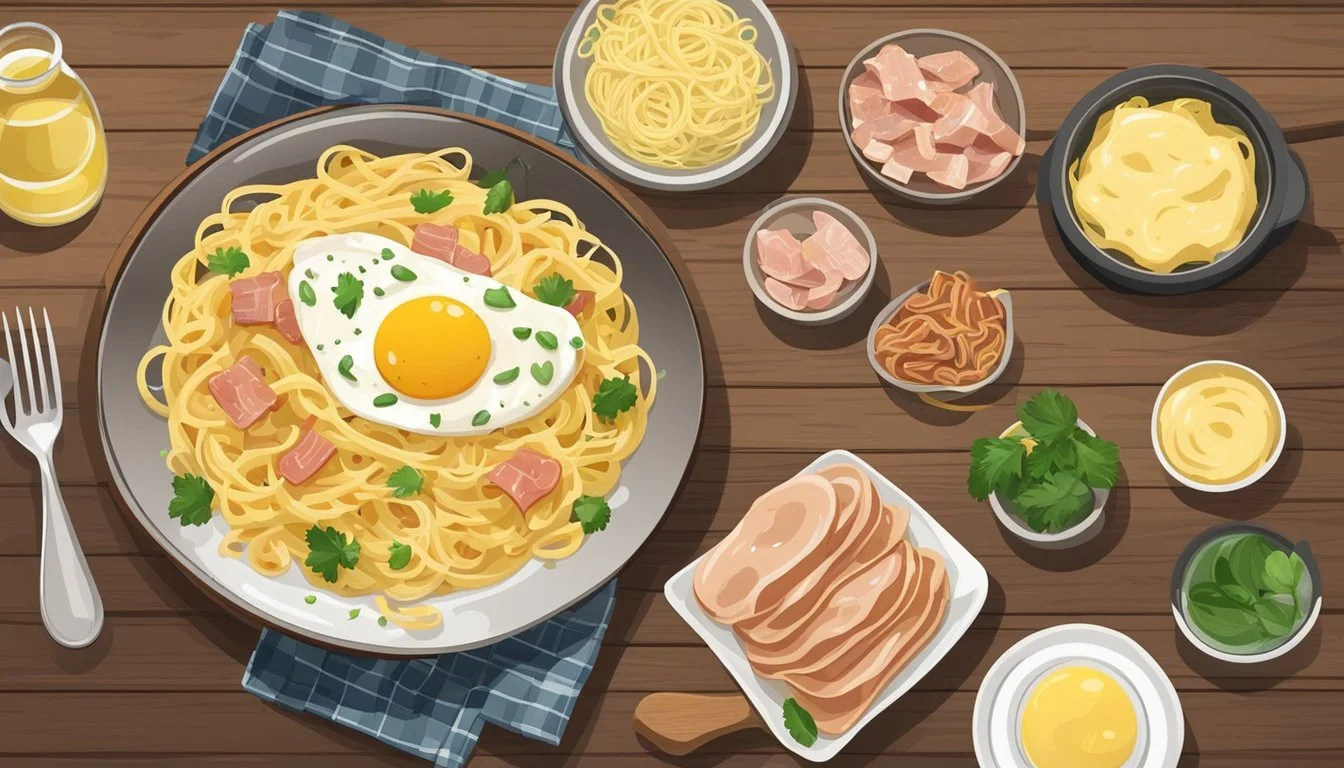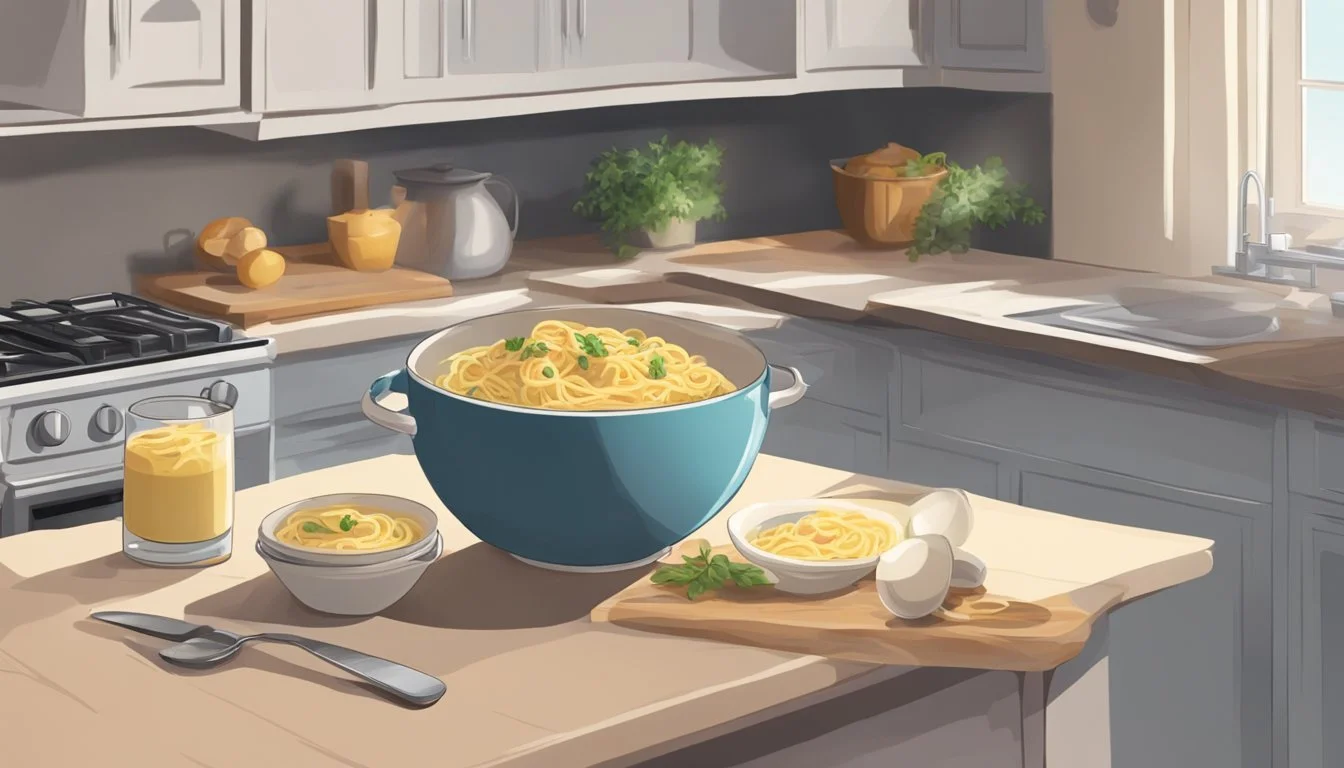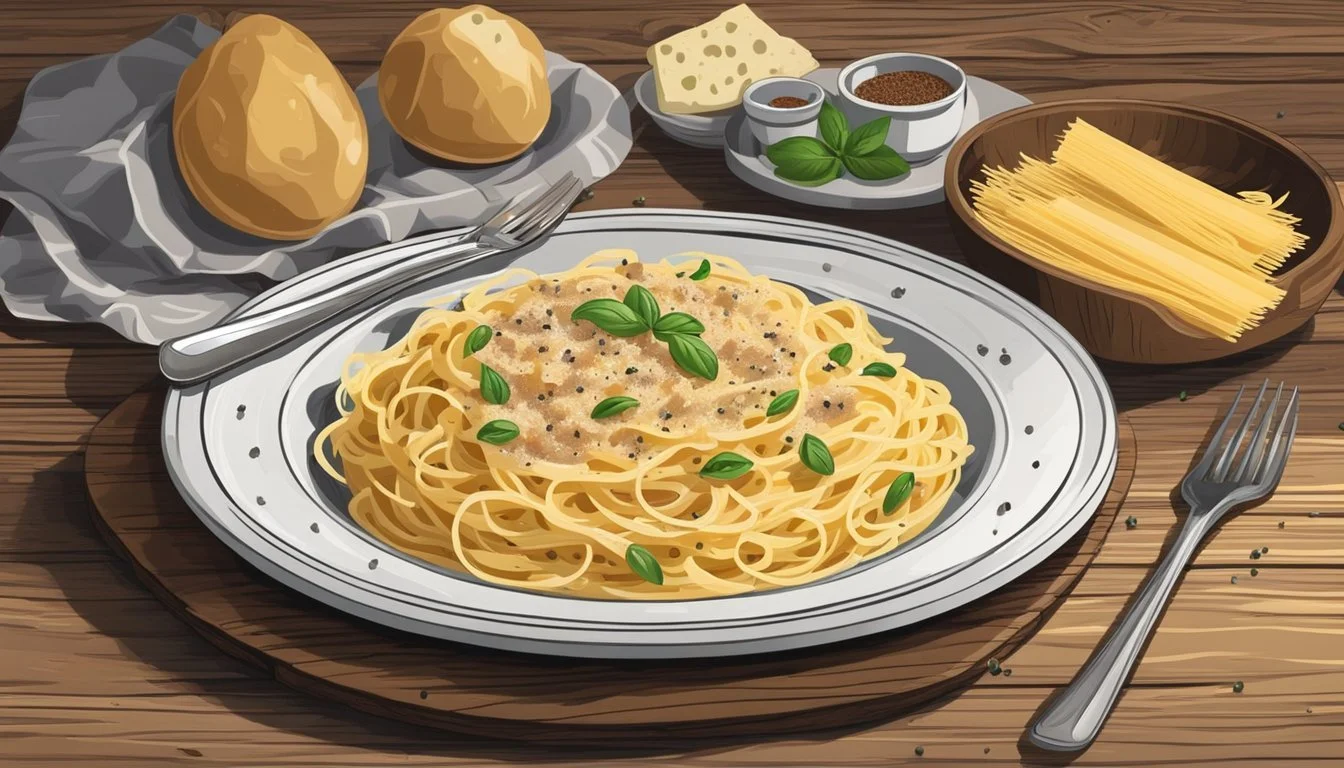How Long Does Freshly Prepared Carbonara Last?
Shelf Life and Storage Tips
Proper storage of food is paramount in ensuring safety and retaining quality. When it comes to freshly prepared carbonara, a delectable Italian pasta (What wine goes well with pasta?) dish made with eggs, cheese, pork, and black pepper, the question of preservation naturally arises. Once prepared, carbonara can last in the fridge for up to three to four days. The dish’s components play a significant role in this period, as the eggs and cheese are highly perishable, dictating the importance of timely consumption.
To maintain the freshness and safety of carbonara, it should be stored in an airtight container and promptly refrigerated. The cooling process should not be delayed; the sooner carbonara is transferred to a cold environment, the better it is for hindering bacterial growth. If the dish is left at room temperature beyond two hours, it significantly increases the risk of foodborne illness. Therefore, swift and correct storage becomes an integral part of preserving carbonara.
Should one find themselves with leftover carbonara, the methods for reheating are simple yet effective in restoring the dish's palatability. It's advisable to reheat only the portion needed, utilizing either a skillet or a microwave, to prevent multiple reheating cycles that could affect its taste and texture. Adding a drizzle of olive oil can revive the dish if it appears dry. It's these careful considerations in storage and reheating that allow one to fully enjoy carbonara in its best form after preparation.
Overview of Carbonara
Carbonara is an Italian pasta dish known for its creamy texture and rich flavors, often hailed as a comfort food staple.
Origin of Carbonara
Carbonara hails from Italian cuisine, more precisely from Roman traditions. The dish's exact origins are disputed, yet it's widely acknowledged as a classic of Italian comfort food. Some theories suggest carbonara was created as a hearty meal for Italian charcoal workers, while others tie its inception to the post-World War II period when American soldiers in Italy combined eggs and bacon with pasta, giving rise to this beloved dish.
Key Ingredients in Carbonara
The quintessential carbonara recipe comprises a few key ingredients, each playing a pivotal role in the dish's creation:
Pasta: Traditionally, spaghetti is used, but other forms of long, thin pasta like linguine or bucatini can also serve as a base.
Eggs: Crucial for the sauce, the eggs are beaten and later mixed with the hot pasta to thicken into a creamy coating.
Cheese: Pecorino Romano, sometimes combined with or substituted by Parmigiano-Reggiano, imparts a salty depth to the sauce.
Pork: Guanciale, cured pork cheek, is preferred, though pancetta is often used as an alternative.
The dish is notably absent of cream, with the silky sauce coming from the emulsion of eggs, cheese, and the pasta's cooking water. This simplicity is the cornerstone of pasta carbonara's appeal and its status as a testament to the ingenuity of Italian cooking.
Preparation Techniques
The quality of a traditional carbonara hinges on its preparation techniques. Mastering al dente pasta, a glossy carbonara sauce, and the harmonious combination of all ingredients is essential to creating this classic dish.
Cooking Pasta to Al Dente
To achieve the perfect al dente texture, boil pasta in salty water until it is just firm to the bite. The exact cooking time varies depending on the type of pasta; for example, bucatini may require a minute or two longer than spaghetti. Using tongs, promptly remove the pasta from boiling water once it's done.
Creating the Carbonara Sauce
The carbonara sauce should be creamy without using cream. Whisk together pasteurized egg yolks, freshly ground black pepper, and cheese—traditionally a mix of Pecorino Romano and Parmesan. It's crucial that these eggs are beaten well and added at the right temperature to achieve a glossy sauce without scrambling the eggs.
Combining Ingredients for Carbonara
In a separate sauté pan, render the fat from the cured pork, such as guanciale or pancetta, until it's slightly crispy. Combine the pasta directly into the pan with the rendered fat to infuse the flavor, then remove from heat before adding the egg and cheese mixture. Toss everything together quickly to create a smooth and creamy carbonara. The residual heat will cook the eggs just enough while preventing them from scrambling. The remaining pasta water can be used to adjust the sauce consistency, ensuring creaminess.
Storing Freshly Prepared Carbonara
When storing freshly prepared Carbonara, it is crucial to ensure that the dish maintains its quality and safety for consumption. Proper storage extends the shelf life, preserves taste, and prevents spoilage.
Ideal Storage Conditions
For optimal freshness, leftovers should be stored in an environment that minimizes exposure to air and bacteria. Airtight containers are imperative for preserving the quality and safety of Carbonara. One should transfer the Carbonara to the container as soon as it reaches room temperature to avoid moisture build-up that can accelerate spoilage.
Refrigeration and Freezing Options
Refrigerator: Store Carbonara in the refrigerator at or below 40°F (4°C) for 3 to 5 days to maintain taste and quality. Keep it on a shelf rather than in the door to avoid temperature fluctuations.
Freezer: For extended storage, freezing is an option. Place the Carbonara in an airtight container or heavy-duty freezer bags. Carbonara can be frozen for up to 2-3 months. While safe to eat beyond this time, its quality, appearance, and feel might diminish.
Detecting Spoilage in Leftover Carbonara
One should inspect the leftovers for signs of spoilage:
Smell: A sour or off-putting odor is a clear indicator.
Color and Appearance: Any change from its original color, or the presence of mold, suggests spoilage.
Feel: Leftover Carbonara should not have a slimy or overly sticky texture.
Proper reheating techniques, such as warming on the stove or in the microwave, can help restore the fresh taste and quality of refrigerated or thawed Carbonara.
Health Considerations
When considering the health aspects of freshly prepared carbonara, one must take into account its nutritional content and potential allergens. Carbonara is a rich dish and can have a significant amount of calories and sodium, which should be taken into consideration for any dietary plan.
Nutritional Content
A typical serving of carbonara can be high in calories due to its ingredients which include pasta, eggs, cheese, and pork. These ingredients contribute not only a high caloric count but also provide protein and calcium, while being relatively low in fiber. Here's a brief outline of the nutritional content in an average serving of carbonara:
Calories: Carbonara is calorie-dense, with a single serving providing a substantial amount of an average daily caloric intake.
Proteins: It offers a good source of protein, essential for muscle repair and growth, from both the eggs and pork.
Calcium: The cheese in carbonara contributes to its calcium content, which is important for bone health.
Sodium: This dish can be high in sodium, which should be moderated in a balanced diet.
Other minerals like magnesium and phosphorus are present in smaller amounts, contributing to overall nutrient intake.
Allergens and Dietary Restrictions
Carbonara contains several common allergens and ingredients that may not be suitable for all diets:
Eggs: A key component of the sauce, posing an allergen risk for those with egg allergies.
Dairy: Cheese, often pecorino or Parmesan, can be an issue for individuals who are lactose intolerant or have dairy allergies.
Gluten: Traditional carbonara is made with pasta that contains gluten, making it unsuitable for those with celiac disease or gluten sensitivity.
Pork: The use of cured meats (What wine goes well with cured meats?) like pancetta or guanciale excludes carbonara from diets that restrict pork consumption.
When serving carbonara, one should always consider these dietary restrictions and allergens, ensuring all diners can enjoy their meal safely and healthily.
Serving Suggestions
When preparing carbonara, selecting the right accompaniments and understanding the best practices for serving and reheating are essential for a delightful dining experience.
Accompaniments for Carbonara
To complement the rich taste of carbonara sauce, one might consider pairing it with a simple salad. This adds a fresh and light dimension to the meal. An array of greens works perfectly, but especially those of the fall season, which bring out the heartiness of the carbonara. Additionally, for those who enjoy long pasta like fettuccine, swapping it with the traditional spaghetti can offer a different texture and surface for the creamy sauce to cling to.
Vegetables: Sautéed or steamed vegetables like asparagus or green beans provide a crisp contrast.
Bread: A slice of crusty bread can be ideal for sopping up any remaining sauce.
Wine Pairing: A glass of crisp white wine balances the creaminess of the dish.
Best Practices for Serving and Reheating
Carbonara is best served fresh, however, if one must reheat it, they should do so gently to prevent the sauce from separating. Avoid the microwave and instead reheat in a pan over low heat, adding a touch of cream if needed to revive the sauce's consistency.
Freshness: Serve carbonara immediately after cooking for the best flavor.
Texture: If reheating, stir constantly to maintain the creamy texture of the sauce.
Variations: While cream is not traditional in carbonara, it may be added to reheat leftovers or to create a sauce more akin to Alfredo or cacio e pepe for variety on a weeknight.
Culinary Variations
In the diverse world of pasta carbonara, chefs and home cooks alike experiment with different ingredients and techniques to create a variety of flavorful adaptations. These modifications cater to various dietary preferences and creative whims, while still paying homage to the classic dish.
Alternative Carbonara Recipes
Traditional carbonara typically features guanciale (cured pork jowl), pecorino romano cheese, eggs, and black pepper, served over a steaming bed of pasta al dente. However, some chefs might substitute pancetta for guanciale for a slightly different flavor profile or use bucatini or rigatoni pasta instead of the classic spaghetti.
Creamy Carbonara: Some variations incorporate cream to create a richer, more indulgent sauce, though this is not traditional.
Pasta Options: While spaghetti is standard, other pasta shapes like fettuccine, bucatini, or rigatoni can also be used.
The transformative tale of carbonara can be traced back to its connection with American soldiers in Italy during World War II, influencing the dish with the addition of cream—a common American adaptation.
Vegetarian and Vegan Adaptations
For those following a vegetarian or vegan lifestyle, carbonara can be adapted without sacrificing the rich, creamy experience the dish is known for.
Vegetarian Version: Guanciale is replaced with mushrooms or zucchini for a meat-free variant, often supplemented with a dash of smoked paprika to mimic the smokiness of the pork.
Vegan Carbonara: Vegan carbonara swaps out all animal products, using ingredients like cashews blended with water (to form a creamy base) and nutritional yeast or vegan cheese to replicate the savory, cheesy flavor. Plant-based bacon substitutes can be used in place of guanciale or pancetta.
In both vegetarian and vegan adaptations, the creativity lies in balancing flavors to echo the traditional carbonara's romance with taste and texture.
Carbonara in Popular Culture
The dish carbonara has evolved far beyond its Roman roots, becoming a significant part of global cuisine and popular culture, celebrated for its creamy texture and delectable taste.
Carbonara's Global Influence
Carbonara, originating from Rome, has transcended its local boundaries to influence and be embraced in various ways across the world. As an emblematic dish of Roman cuisine, carbonara quickly gathered international attention, often serving as a culinary representative of Italian cuisine on the global stage. Its simplistic yet rich flavor profile has made it a favorite in household kitchens and high-end restaurants alike, reflecting the adaptability and universal appeal of Italian dishes.
Americas: After World War II, American soldiers returned home with a fondness for carbonara, having been introduced to it in Italy. This affection helped propel the dish into the American culinary scene.
Global Restaurants: Today, myriad restaurants around the world feature carbonara on their menus, testament to its global influence and popularity. It is often used as a benchmark to gauge the authenticity and quality of an Italian dining establishment.
Iconic Moments
Carbonara has been featured in various forms of media, from films to literature, where it often symbolizes Italian culture or the quintessential Roman experience. The dish's appearances often evoke a sense of nostalgia for the eternal city and impart a touch of Roman authenticity.
Cinematic Highlights: In film, carbonara has often been portrayed as a comforting and unifying meal, offering a glimpse into everyday Roman cuisine.
Literary Mentions: Literature too has chronicled the dish's significance within Italian food (What wine goes well with Italian food?) culture, sometimes highlighting its humble beginnings and its ascent to international fame.
A true testament to carbonara's cultural impact is its journey from a simple pasta dish to an iconic element of global culinary appreciation, bridging the gap between traditional Roman cuisine and modern global dining trends.
Additional Resources
When seeking out high-quality resources for carbonara recipes, ingredients, storage, and cooking advice, culinary enthusiasts should consider the following:
Recipes and Ingredients:
Epicurious and Serious Eats: These sites provide tried-and-tested carbonara recipes. They emphasize using quality ingredients such as fresh eggs, Pecorino Romano or Parmigiano-Reggiano, and guanciale or pancetta.
Local Farmer’s Markets: For the freshest eggs and pork products, one might explore these markets. The quality of these ingredients is crucial for authentic carbonara flavor.
Storage Tips:
FoodSafety.gov: An authoritative source for safe food storage practices. They offer guidelines on how long different ingredients can be safely stored in the refrigerator or freezer.
StillTasty: This comprehensive food storage database gives detailed shelf life information, including tips on storing cooked carbonara.
Cooking Tips:
Cook's Illustrated: They provide food science insights and practical tips to perfect the cooking process of dishes like carbonara.
Reheating Techniques:
The Kitchn: This kitchen-centric resource offers clever reheating methods to restore the carbonara's fresh taste while maintaining its creamy texture.
Kitchen Essentials:
Wirecutter: They review kitchen gadgets and cookware, helping chefs select the best tools for preparing carbonara, from non-stick pans to pasta pots.
Each source offers clear, neutral, and knowledgeable advice that can enhance one's culinary experience, ensuring that one's carbonara is both delicious and stored correctly for safe consumption.









